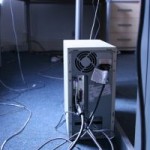The changing face of the IT department
The role of the IT department has changed, and modern IT functions need to re-invent themselves to maintain their relevance and role within the modern enterprise. The changing IT department is moving from the nerds in the basement to real business partners.
The Changing Face of the the IT Department
The role of the IT department is changing, the face that is presented to the business needs to evolve to be more relevant for the current needs of modern business. The way the business sees IT needs to be changed from the old perceptions that they may have.
The old world – last century
Cast your mind back to the role of the IT department in the 80’s, 90’s and even the 2000’s – their role was to implement and run the on-premises datacentre, networking, workstations and servers. The IT team would probably also be responsible for almost anything that had a power cable too! IT would likely develop bespoke software, or heavily customise or modify any software components that were procured – line of business applications were created by the IT department by combining multiple components together.
The ‘Helpdesk’ had a focus on break/fix, dealing with users who may not have had training on how to use a computer, or Windows – let alone the bespoke company software systems. Most of the time, the Helpdesk’s answer would be that you need to reboot. The only interaction most of the business would have with IT would be when they complain that something had crashed or stopped working. The workstations were heavily locked down by IT, software was installed on them as an image (like Ghost) when they were first purchased, and upgrades only happened when the hardware was replaced – all software had to be installed by IT, and problems would take many hours whilst the IT department re-imaged a PC. There may be computers under desks that were running critical workloads (with a PostIt saying “do not switch off!”, the room where the IT department worked was piled high with old computer components and cables. Working from home required a dial-up connection to a bank of company modems, if you were lucky (or rich) enough to have a home computer – but there would be very little you could do without the company software installed. The IT department would be within the finance department, and constantly have it’s budget being squeezed for being considered to be a cost to the business, making capital purchases with a relatively short depreciation period (compared to other business capital assets).
The new world …?
So, now that you have either nodded your head in agreement, or cringed at the memories [of having to fix the coffee machine, because it had buttons and a plug – so it must be IT’s role to fix], what is today’s changing IT department responsible for?
I’ll start with training – with the consumerisation of IT, there is a decrease in the need to train people on basic computer skills. Instead of IT departments building bespoke applications, COTS solutions can meet most needs, and people may have already utilised them in the past.
The standard language of user interfaces and computer systems has become part of society’s language, reducing the need for training.
There is still a need for custom developed applications, particularly for niche business needs – however, can the business change how it works to leverage packaged software? Are the business needs really so unique that no-one sells a pre-developed package?

Datacentres are shrinking – not just because servers are smaller and more capable, not simply because of virtualisation, but also due to the move to consumption-based Cloud solutions and services. Not simply a move of applications to someone else’s computer, but an evolution to services instead of infrastructure. Many businesses are shrinking their datacentres down to the equivalent of a wiring closet, and with a shift to wireless networking and activity based working causing a shift to working from home, even the number of network sockets required is decreasing.
Working from home becomes so simple that businesses are weaving it in to their office design with activity based working and disaster recovery, no more banks of dial-up modems! Staff can bring their own device (many companies even prefer it), and most have a home computer that is able to get to company resources simply through either a VPN or logging on to a cloud service (with MFA / 2FA of course), and remote working with a virtual desktop may even be the same desktop as they use when in the office.
A locked down computer is a hindrance to staff – the ability to install software is expected and required by staff. The shift from having a perimeter of protection, and then restrictions to stop software installation within that protected zone are now made obsolete by shifting the perimeter to be around every server and service, tightening security to a ‘least access’ approach on defined ports and protocols (instead of all ports for poorly secured applications), caused by the shift to BYOD.
With the evolution to a Service Desk, this was the start of the journey where the changing IT department is becoming more able to partner with the business to work on their needs – not just respond to problems, complaints and failures. Desktop sharing and remote management capabilities can let the Service Desk diagnose a problem instead of just rebooting to make it go away, engaging with the user to resolve the problem – and showing that the problem is not caused by the IT department. A shift to a Service Desk proves to the business that services can be offered and requested, and with a well designed and defined Service Desk capability that is flexible to needs, it can help cut off the risk of Shadow IT bypassing official channels.
The journey
IT is evolving beyond being seen as the “cause of problems” and as a cost to the business. Making a shift to Mode 2 (Gartner BiModal) and offering systems of differentiation and innovation requires a closer relationship with the business – beyond just a responding to issues and requests. Building these relationships needs to be performed on levels of trust that are rooted in the business’s perception of IT. This may require a restructure, change of leadership or team members, renaming (or re-branding, depending upon the size of the business), and a level of marketing to show the changing IT department focus.
With less servers to manage, less applications installed on company PCs (and less company PCs), the remote experience almost the same as on-premises working, the use of generic packaged [COTS] applications instead of custom-integrated systems that need dedicated training and support, less helpdesk calls from users who don’t know how to use a computer – all adds up to a changing IT department. The future is not more of the same, it’s a new relationship with the business and users.

